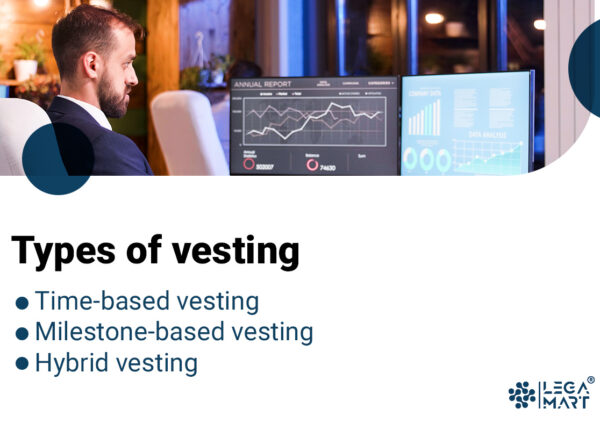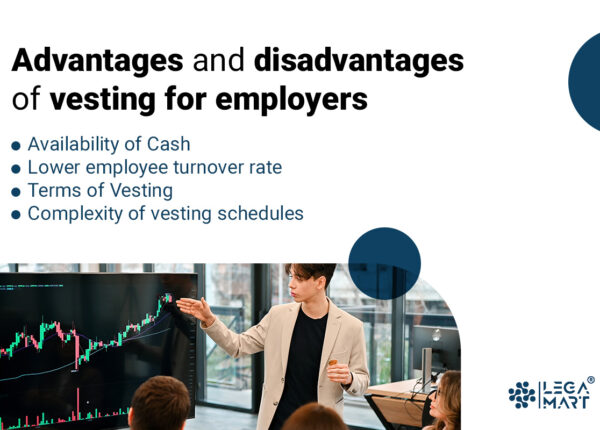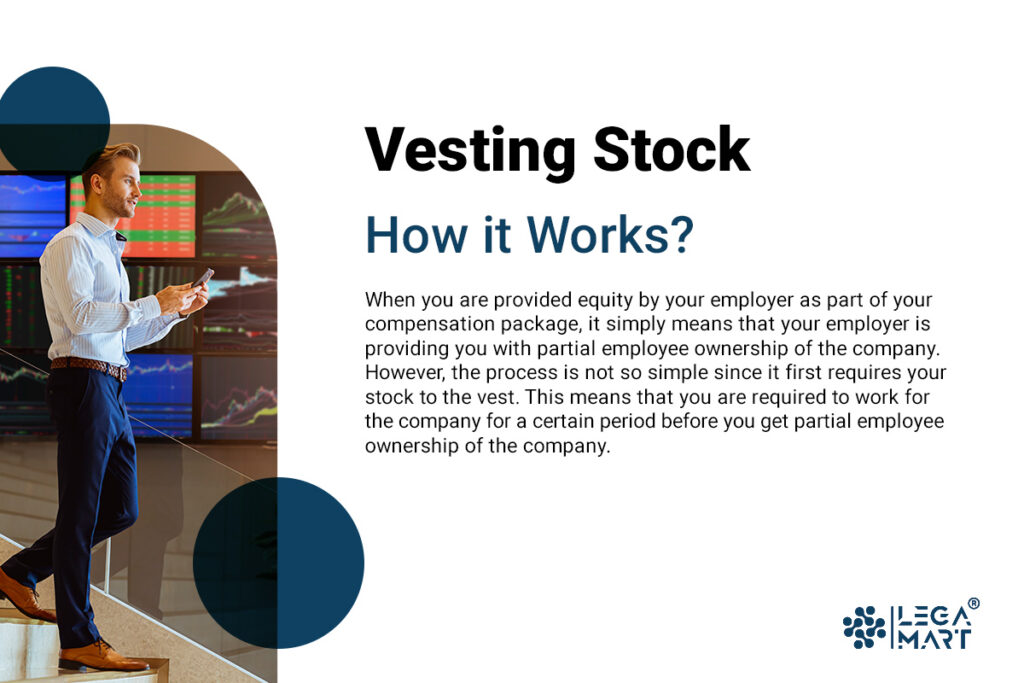- Introduction
- What is vesting stock?
- Types of awards and benefits that vesting applies to
- What is a vesting schedule?
- Types of vesting
- Importance of vesting for startups
- What happens if an employee leaves prior to being fully vested?
- Advantages and disadvantages of vesting for employers
- Conclusion
- Frequently Asked Questions (FAQs)
Introduction
When you are provided equity by your employer as part of your compensation package, it simply means that your employer is providing you with partial employee ownership of the company. However, the process is not so simple since it first requires your stock to the vest. This means that you are required to work for the company for a certain period before you get partial employee ownership of the company.
So, how does this materialise in practical scenarios? Let’s find out!
What is vesting stock?
Vesting is earning an asset through employer-matched contributions or stock options. It is used by companies to encourage their employees to stay and work longer for the company.
Regarding employee compensation, through vesting stock, an employee can hold company shares, either through employee stock options (ESOs) or restricted stock units (RSUs). However, these company shares are not yet earned by the employee.
In practical terms, these stock options are provided as part of the employee compensation plans, accompanied by vesting schedules. Therefore, the employee is expected to hit certain achievements and targets to gain the right to own the shares.
While it is usually tied to time, wherein the employee is expected to work for the company for a certain period to get them, it is possible to attach it with certain milestones as well.
Types of awards and benefits that vesting applies to
The term “vesting” might be used for providing a range of awards and benefits to the employee:
Employee Stock Options (ESOs). When the stock becomes fully vested (i.e., when the person earns the right to the full amount of some benefit), the employee earns the right to an option to purchase the shares that were granted to them in the past, irrespective of the stock price in the present or the fair market value of the stock. Therefore, the employee can buy several shares in the company stock in the future at the agreed price of the past.
Restricted Stock Units (RSUs). When the stock becomes fully vested, the employee earns the right to outright ownership through a restricted stock unit. Here, the RSU shares are earned through an agreed vesting schedule, which is followed for the stock option grant for vested RSUs.
Restricted Stock Awards (RSAs). When the grant of company stock has been restricted in certain ways. Here, while the employee is granted ownership over the vested stock at a specific date, the rights can be exercised if certain conditions have been met.
Qualified Retirement Plans. Some companies prefer their retirement plans to have employer-matching contributions. This simply means that the employee adds in and matches the percentage of money that the employee puts in. The employee might also add more money if specific vesting requirements are met following the vesting schedule.
Example: A qualified 401(k) account. 401(k) is a United States retirement and savings plan wherein employees contribute a portion of their salary or paycheck towards the retirement fund. Therefore, if a 401(k) account is used as a qualified retirement plan, then along with the employee, the employer also makes contributions towards the employee’s retirement plans.
Pension Plans. Through these plans, an employer is committed to regularly contributing payments to the employee after retirement. These can be costly for the employer and hence, might necessarily include a vesting schedule.
If you are curious to know what other contracts an employee should know about, refer to a related article:
7 contracts that an employee should know about
What is a vesting schedule?
The schedule is used to clarify what must be done before the employee earns the right to exercise their vested stock option grant. It might be based on a time-based schedule, a milestone-based schedule, or both. However, the most common practice is to outline a certain number of years of service that must pass with the company before the employee is considered fully vested.
A vesting schedule is mainly of 2 types:
Graded vesting schedule. Here, the employee gains ownership over their options or shares over time or after achieving specific milestones.
Cliff vesting schedule. Here, the entirety of the award is granted after a specified period.
Types of vesting

There are mainly three types of vesting stock grant options used:
Time-based vesting
Through this method, employees can earn their share of the stock grant options over time. This is based on a set of schedules and a cliff – mainly when the first options are granted and become exercisable for the option holder. Once the cliff stage has been reached, the remaining options granted are based on quarterly or monthly, depending on how the vesting schedule was originally designed.
The usual practice is to offer vesting stock options with a four-year vesting schedule and a one-year cliff period. This means that the minimum time that the employee must stay in the company before starting to earn the interest would be one year from the joining date, and thereafter, the employee shall get the fully vested shares after four years of service with the company. Of course, this period might be subject to change depending on the specific policies of the company involved.
Example – A is an employee at company B. According to the policies of company B, A has been provided with a five-year vesting schedule and a total of 2000 shares. So, after the completion of 1-year, A shall manage to earn 400 exercisable stock options, and thereafter, A shall receive 33.33 shares each month for the next four years. Therefore, each year, A would obtain certain ownership over the company.
Milestone-based vesting
Through this method, the option holder is able to receive their stock options based on the completion of certain specific tasks or after the achievement of certain objectives, as set by the employer or the vesting schedule. Some also consider this type of agreement ‘phantom stock’.
Example – For an employee working in sales/marketing department of a company, the schedule may envisage a situation where the option holder will receive certain shares after meeting the sale targets. Similarly, employees in an accounting firm might be able to get stock options once they have reached a certain number of audits in the company. This type of vesting is very dynamic and mostly dependent on company practices.
It is also possible for the company to go for milestones applicable to the whole business instead of going for an employee-specific milestone. In such a case, once the business can achieve a certain target, it would be possible for all employees working in the company to benefit from stock options.
Hybrid vesting
As the name suggests, this stock vesting combines time-and milestone-based vesting. Therefore, employees are expected to stay in the company for a certain amount of time, and reach specific milestones, to become eligible for an exercisable stock option.
The time and milestones might be connected (i.e., the employee might be expected to reach certain milestones in a certain time) or unconnected, depending on the company policies and practices.
Importance of vesting for startups
Developing a startup is a challenge, especially with the limited capital available. In addition, the compensation, hiring, and retaining employee talent is an added difficulty that the company must survive, especially at the starting phases of the startup.
In such situations, giving away employee equity compensation is often used to attract the right people and talent. The company is able to achieve a capital gain in a short period. However, it must also be remembered that giving away partial ownership over the company has its risks. Therefore, the decision must be made wisely.
Vesting stock or share vesting can help a company achieve three objectives:
- Incentivising long-term commitment to the company
- Demonstrating a commitment to company growth
- Protecting the company in case the relationship between the employee and employer doesn’t work out.
The contractual share option promise can incentivise the employees to stay loyal to the company. Further, it incentivises the employee to work for the company at least till the period is over or till the milestone has been achieved.
From the investor standpoint, vesting stock might be able to show that the founders are committed towards the growth of the company, and to paying the employees despite the limited access to capital.
What happens if an employee leaves prior to being fully vested?
If the employee leaves before fulfilling the fully vesting requirement, as might be mentioned in the schedule, then the employee will have to surrender or forfeit all of their unvested shares or options. This also applies to any other employment benefits that have not reached the stage of fully vested.
We must be reminded that the main reason stock options are provided to an employee is to retain the employee for as long as possible. Therefore, if an employee decides to leave a company after 6 months and still manages to receive the vested options, then the option pool shall shrink for future employees or those who decide to complete their vesting period.
Advantages and disadvantages of vesting for employers

Availability of Cash. Vesting stock is a form of employee compensation often used as a substitute for a cash bonus and rewards in addition to ordinary income. Therefore, the company can maintain a higher share of cash, which might be used to pay off the current liabilities or used in emergencies.
Lower employee turnover rate. Through vesting, employers are able to ensure loyalty and the long-term future of the company.
Terms of Vesting. If the vesting options have harsh vesting terms involved, it might act as a disincentive for the high-calibre employees. Therefore, the options must be considered cautiously before a company decides to go forward with the investment.
Complexity of vesting schedules. The designing and execution of schedules require time and effort from employees, which can have high opportunity costs for the employer. This might increase if the schedules cannot incentivise the employees to stay in the company.
Conclusion
Irrespective of whether you are a startup founder, a human resources professional, or an employee, learning about vesting stock units and stock options provided is a necessity. This procedure is capable of having a significant impact on your company and professional life.
Understanding the process might be difficult for some people. Therefore, if you have any questions or want a lawyer or financial advisor to review the terms in your stock options agreement (or vesting agreement), refer to LegaMart’s professional team of lawyers, who will help you with everything you want to know.
Frequently Asked Questions (FAQs)
What is vesting?
It is the process of gaining full ownership of an asset. It is not possible for an employee to have full control over the asset unless the vesting period has passed. Once the vesting period has been completed, the employee can use or dispose of the asset.
What is the vesting schedule?
It is used to clarify what must be done as part of the vesting requirement before the employee earns the right to exercise their stock options. It might be based on a time-based vesting schedule, a milestone-based vesting schedule, or both. However, the most common practice is to outline a certain number of years of service that must pass with the company before the employee is considered fully vested.
What happens to vesting stock when you quit?
When you quit before completing the vesting schedule, you can keep the vested equity, and the unvested equity shall be forfeited. The forfeited equity grant shall return to the company stock pool and might be offered to another employee as employee equity compensation. Incentive stock options usually expire within 90 days of leaving the company. Therefore, if you haven’t exercised your vested equity grant within 90 days of leaving the company, it is possible that you would lose your vested options.





